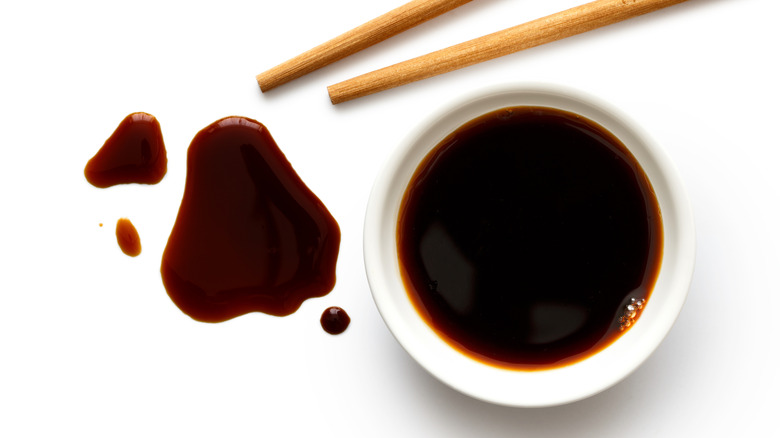Soy Sauce Vs Table Salt: Which Is The More Nutritious Choice?
We may receive a commission on purchases made from links.
Salt is magic — just a pinch can transform a bland dish into something brilliant. But too much salt can cause a host of health issues like high blood pressure, headaches, and kidney disease — and most of us are eating way, way too much. The average American consumes over 3,300 milligrams of sodium per day, far more than the 1,500 milligrams recommended by the American Heart Association (AHA). Just one teaspoon of pure table salt contains roughly 2,400 milligrams, so are there more nutritious ways to get your sodium fix other than salt? Say, soy sauce?
The Takeout asked chef Maricel Gentile, author of Maricel's Simply Asian Cookbook and founder of Maricel's Kitchen. "Neither is nutritious in the sense of adding vitamins," she said, "but soy sauce, when used in small amounts, gives you more flavor impact with less actual sodium than an equal amount of salt."
One tablespoon of the salty sauce contains roughly 902 milligrams of sodium — a lot less than salt, but still over 50% of your daily recommended dose by the AHA. "For someone watching sodium, it can be a flavorful swap, though moderation is key either way," Gentile said.
Can you use soy sauce in place of table salt?
Though salt and soy sauce are both seasonings that can enhance flavors, Maricel Gentile explained that they serve different purposes. "Soy sauce is more complex because it is layered with salty, sweet, and fermented notes," she said. "Salt, by itself, is clean and sharp, but soy sauce tells a whole story with every drop."
Then there's MSG, the unfairly-labeled bad guy that is actually an umami flavor bomb. MSG, or monosodium glutamate, combines salt and glutamate, an amino acid. Like salt and soy sauce, MSG is known for its ability to enhance flavors, but it works in a different way. While salt can enhance both sweet and umami notes, MSG mostly brings out umami. It's present in some types of soy sauce, but it's not the sole flavor source. "The [soy sauce's] umami does not come just from MSG, but also from the natural fermentation process, which creates glutamates that deepen flavor," Gentile shared.
While table salt, pure MSG, and soy sauce all add depth and nuance to a dish, they can't necessarily create the same results. "With soy sauce, you get both seasoning and a depth of flavor that cannot be replicated with just table salt," Gentile said.
Not all soy sauces are created equal
Soy sauce varies, with Japanese, Chinese, and Filipino soy sauces all having their unique flavors, and some are saltier than others. Maricel Gentile said, " ... when people say 'soy sauce,' they often treat it like one thing, the way we might think of cola. But just like Coca-Cola and Pepsi are technically both cola but taste different, soy sauces range widely in flavor, sweetness, saltiness, and even aroma."
She continued, "Also, the color of soy sauce does not actually tell you how salty it is. Dark soy sauce looks intense but can be milder in sodium, while light soy sauce, despite the name, can taste saltier." If you're unsure which soy sauce to use, you can always opt for low-sodium sauce and add salt to taste, like a baker using unsalted butter to better control the level of salt. Low-sodium soy sauce has its own unique flavor, though. "Low-sodium soy sauce can taste a little thinner, since the balance of salt and fermentation shifts," Gentile explained. "I like to use low-sodium versions in dishes where other strong ingredients, like garlic or ginger, carry the flavor."
In short, soy sauce can be a swap for salt — as long as you know what you're doing. You can still get experimental, though. Soy sauce adds umami oomph to baked goods, and a splash of soy takes your Thanksgiving gravy to the next level.


